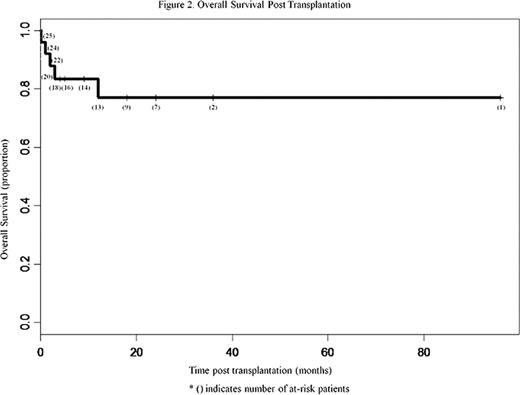Abstract
Abstract 4499
Stem cell transplantation (SCT) has been shown to improve the outcome of non-Hodgkin’s lymphoma patients who fail to respond to initial therapy or have relapsed disease, but the optimal conditioning regimen prior to transplant has yet to be determined. Busulfan, cyclophosphamide, and etoposide (Bu/Cy/VP-16) conditioning prior to transplant has been investigated in non-Hodgkin’s lymphoma (NHL). We investigated the outcomes of patients treated with this conditioning regimen at the Northwestern University Robert H. Lurie Cancer Center.
A retrospective analysis of all relapsed/refractory NHL patients who received SCT from 3/2003–6/2011 at the Northwestern University Robert H. Lurie Comprehensive Cancer Center using Bu/Cy/VP-16 conditioning was performed. Detailed patient and disease-related characteristics were collected. Furthermore, we analyzed overall survival (OS), progression free survival (PFS), and disease free survival (DFS).
We identified 25 relapsed/refractory NHL patients who received Bu/Cy/VP-16 conditioning with SCT. The median age of all patients was 49 (range: 28–71). Thirteen of 25 patients (52%) had allogeneic SCT (alloSCT) and 12/25 (48%) had autologous SCT (auSCT). Among the alloSCT, 10/13 (77%) were matched sibling donor (MSD), and 3/13 (23%) were matched unrelated donor (MUD). Six of 25 (24%) had low grade lymphoma (5 follicular, 1 marginal), 17/25 (68%) had aggressive lymphoma (9 diffuse large B-cell lymphoma (DLBCL), 1 chronic lymphocytic leukemia (CLL)/DLBCL Richter’s transformation, 2 DLBCL/follicular, 1 follicular large-cell (i.e., grade 3B), 3 mantle cell lymphoma (MCL), and 1 lymphoblastic lymphoma), and 2/25 (8%) had mixed NHL and HL disease. Of note, of the aggressive NHL patients, 13/17 (76%) had primary refractory disease or relapse less than 12 months after initial remission. The median number of prior therapies was 3 (range: 1 to 7). For all patients (n=25), median follow up time post-transplant was 12 months (range: 5 days–96 months). PFS for all patients was 71 ± 10 % (95% confidence interval (CI): 53–95%) (Figure 1). OS for all patients was 77 ± 9% (95% CI: 61–98%) (Figure 2). Four of 25 patients (16%) died less than 100 days after SCT, 2 of which were alloSCT and 2 of which were auSCT, from causes including hypoxemic respiratory failure, sepsis, and progressive disease; all of these patients had aggressive lymphoma (2 DLBCL, 1 lymphoblastic lymphoma, and 1 MCL) and primary refractory disease. Six of 25 (24%) had progressive disease at less than 12 months post transplant, and no patient has relapsed beyond 12 months. Finally, DFS for all patients was 85%.
Altogether, our experience with Bu/Cy/VP-16 conditioning prior to either auSCT or alloSCT in relapsed/refractory NHL patients suggests that this is an effective and viable conditioning regimen with excellent outcomes including high PFS of 71%, OS of 77%, and DFS of 85%. Furthermore, these outcomes were apparent despite several high risk features among these relapsed/refractory patients.
No relevant conflicts of interest to declare.
Author notes
Asterisk with author names denotes non-ASH members.



This feature is available to Subscribers Only
Sign In or Create an Account Close Modal